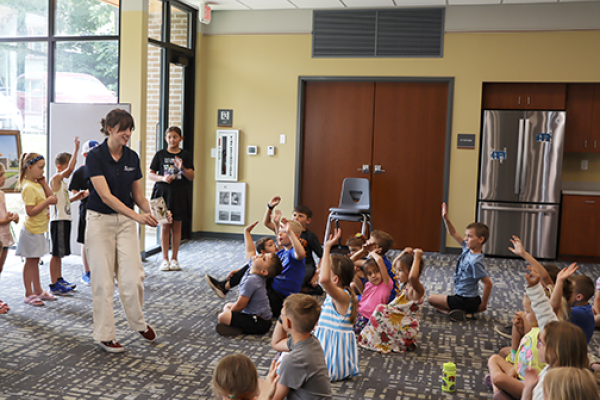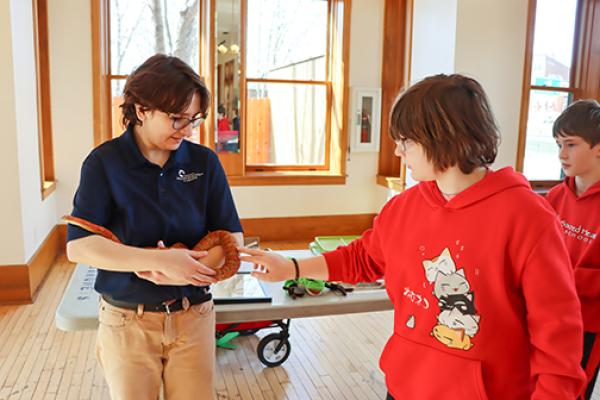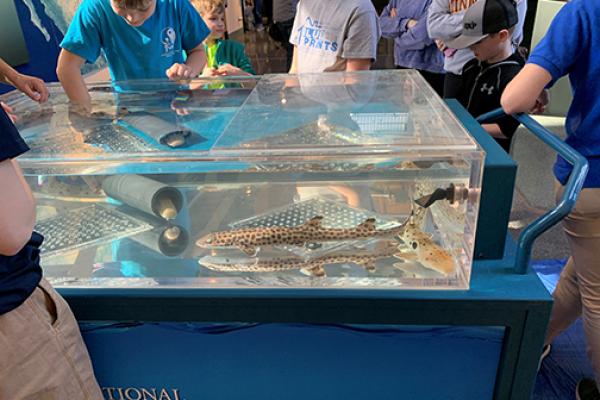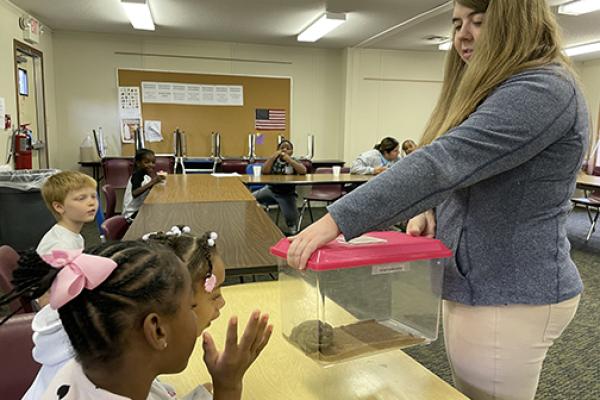The National Mississippi River Museum and Aquarium is a place of exploration, learning, conservation, and creativity. As part of our mission to inspire stewardship through educational activities, our outreach programs offer the opportunity to bring the NMRMA to your community. Outreach programs are led by NMRMA educators at your libraries, schools, community centers, and more. Choose from a variety of programs that cover topics including history, science, and animals- with some programs offering the chance to bring some of our ambassador animals to your location! If you are interested in booking or learning more about our outreach programs, you can submit an inquiry through this page.
We have several different outreach programs for different educational focuses and age groups. We are also happy to work with you to adjust our programming to meet your age group or theme requirements.
- Our outreach programs are 60 minutes with the ability to add an extra hour for a 2nd program or additional animal touch time.
- Outreach Program Pricing: $225 | Ocean Odyssey is $500
- Add-on an additional 1-hour (same program, same location): $125
- Mileage Per Mile: Federal Rate (0.70 per mile)
- Our programming reach is a 2-hour drive or 100 miles from Dubuque, IA.
*If your location is outside the 2-hour or 100 miles reach, please see our Distance Learning options.
Contact our education team at 563-557-9545 x222 or learning@rivermuseum.org with questions.
Submit Inquiry
Thank you to our sponsor
ITC Midwest
Programs
Animals of the Mississippi
Mussels, snakes and beavers; each species has a niche or role in the environment. Through the use of pelts and other hands-on items, participants will explore animals that call the Mississippi River home!
Keywords: Adaptations, Native Species, Classification, Habitats, Biodiversity
Animal Story Time
Join us for story time with one of our Animal Ambassadors. Meet the star of the story while learning animal facts along the way. Animal options are snake, frog, turtle, or lizard.
Keywords: Early Childhood/Early Elementary, animal behaviors, life cycles, diet, life science
Tales and Scales
Explore the fascinating world of reptiles through exciting myths and scientific facts where students can learn the truth behind myths and wives tales.
Keywords: Life science, fiction and non-fiction, adaptations for survival (Prey and Predators), animal behaviors, scientific literacy and storytelling
Rockin' Reptiles & Awesome Amphibians
Learn the similarities and differences of reptiles and amphibians. Meet our Animal Ambassadors.
Keywords: Animal adaptations, comparative anatomy, species identification, Herpetology, habitats, survival, ecological roles
An Animal Chorus
Explore different ways animals communicate with each other. Transform into an animal chorus and meet live animals up close!
Keywords: Animal Communication (vocalization, sounds), territory signals, social interactions, comparative biology, sensory perception, environmental influences
World of Metamorphosis
Follow the life of insects and amphibians and see how they change from tiny eggs in the water to animals living on land or in the sky.
Keywords: Life Cycle, Metamorphosis, Reproduction, Observation & Inquiry, Habitats
Not so Creepy Crawlers
Meet common invertebrates such as beetles, tarantula, roach, and millipede. Learn what has helped them survive.
Keywords: Invertebrates, Adaptations, Diversity, Survival traits
Ocean Odyssey Touch Tank
Our traveling touch tank can bring live ocean animals to you. Break down common misconceptions surrounding sharks or string rays as we highlight the unique adaptations these animals have to survive. Afterwards, participants may get their hands wet and touch some of these animals.
Program Price: $500
Keywords: Ecosystem, Animal Adaptations, Food Chain, Keystone Species, Misconceptions
Human, River, and Land Connection
An explorer’s life was one of travel and trade, as they encountered new landscapes, new cultures, and new wildlife in the Driftless area. Examine how the lives of historic individuals were influenced by the Upper Mississippi River and its unique land features. Learn how we have been impacted by natural resources like furs and lead.
Keywords: Behavioral sciences, economics, geography, local history, trade and commerce
Life in a One Room School House
This outreach program’s target audience is Adults. We offer a student-centered version for field trips.
Learn about one-room schoolhouses and early education. Then we'll put the audience to the test by taking an 8th-grade graduation exam from the 1850s. It may be harder than you think!
Keywords: Change and continuity, communities and cultures, civic ideals, United States History, historical perspective, primary sources, comparative education: daily life
Watershed Connections
Do you know how your actions affect the overall health of the Mississippi River? Investigate humans’ effect on our watershed and explore conservation practices to keep it healthy. Our 3D Enviroscape model allows you to see how pollution from different sources can affect lakes, rivers, and streams.
Keywords: Conservation, Pollution, Human Impact, Environment, Erosion, Watershed





